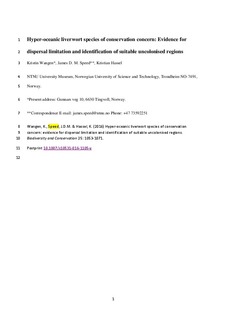Hyper-oceanic liverwort species of conservation concern: Evidence for dispersal limitation and identification of suitable uncolonised regions
Journal article, Peer reviewed
Permanent lenke
http://hdl.handle.net/11250/2426961Utgivelsesdato
2016Metadata
Vis full innførselSamlinger
- Institutt for naturhistorie [1213]
- Publikasjoner fra CRIStin - NTNU [37215]
Sammendrag
In order to successfully manage and conserve species and plant communities, it is important to have a good understanding of their ecology and distributions. The three liverwort species Anastrophyllum donnianum, Scapania ornithopodioides and Scapania nimbosa, are restricted to the mixed northern hepatic mat community found in the most oceanic parts of north-western Europe. These species are of conservation concern because they are globally rare with strict environmental requirements and a limited dispersal potential, which makes them vulnerable to disturbance and climate change. In this study we used species distribution modelling to (1) predict their potential distribution in Norway (2) to assess whether they are limited by dispersal or suitable climate, (3) identify which climatic factors are most important in determining their distribution and (4) suggest regions for further field based surveys. Maximum entropy (MaxEnt) models were developed for each species using target-group background data, and five environmental coverage layers. Our results indicate that all three species are limited by dispersal rather than the availability of suitable areas in Norway. In particular, A. donnianum seems to be limited from reaching uncolonised highly suitable areas in northern Norway due to a barrier unsuitable region with insufficient summer rain. S. ornithopodioides is absent from northern Norway despite the presence of highly suitable regions scattered along the coast. The models locate highly suitable areas where conservation measures should be focused when they overlap with known populations. Areas of interest for targeting searches for potentially undiscovered populations are indicated.
